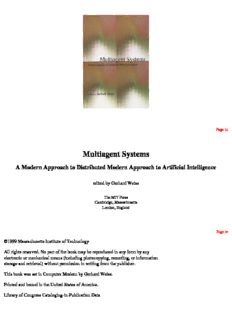Table Of ContentPage iii
Multiagent Systems
A Modern Approach to Distributed Modern Approach to Artificial Intelligence
edited by Gerhard Weiss
The MIT Press
Cambridge, Massachusetts
London, England
Page iv
©1999 Massachusetts Institute of Technology
All rights reserved. No part of the book may be reproduced in any form by any
electronic or mechanical means (including photocopying, recording, or information
storage and retrieval) without permission in writing from the publisher.
This book was set in Computer Modern by Gerhard Weiss.
Printed and bound in the United States of America.
Library of Congress Cataloging-in-Publication Data
Multiagent systems: a modern approach to distributed artificial intelligence / edited
by Gerhard Weiss
p. cm.
Includes bibliographical references and index.
ISBN 0-262-23203-0 (hardcover: alk. paper)
1. Intelligent agents (Computer software) 2. Distributed artificial intelligence.
I. Weiss, Gerhard, 1962- .
QA76.76.I58M85 1999
006.3—dc21 98-49797
CIP
Page v
CONTENTS IN BRIEF
Contributing Authors xix
Preface xxi
Prologue 1
Part I: Basic Themes
1 27
Intelligent Agents
Michael Wooldridge
2 79
Multiagent Systems and Societies of Agents
Michael N. Huhns and Larry M. Stephens
3 121
Distributed Problem Solving and Planning
Edmund H. Durfee
4 165
Search Algorithms for Agents
Makoto Yokoo and Toru Ishida
5 201
Distributed Rational Decision Making
Thomas W. Sandholm
6 259
Learning in Multiagent Systems
Sandip Sen and Gerhard Weiss
7 299
Computational Organization Theory
Kathleen M. Carley and Les Gasser
8 331
Formal Methods in DAI: Logic-Based Representation and Reasoning
Munindar P. Singh, Anand S. Rao, and Michael P. Georgeff
9 377
Industrial and Practical Applications of DAIH.
Van Dyke Parunak
Page vi
Part II: Related Themes
10 125
Groupware and Computer Supported Cooperative Work
Clarence Ellis and Jacques Wainer
11 459
Distributed Models for Decision Support
Jose Cuena and Sascha Ossowski
12 505
Concurrent Programming for DAI
Gul A. Agha and Nadeem Jamali
13 539
Distributed Control Algorithms for AI
Geraint Tel
Glossary 583
Subject Index 609
Page vii
CONTENTS IN DETAIL
Contributing Authors xix
Preface xxi
Purpose, Features, Readership, How to Use This Book, One Final Word,
Acknowledgments
Prologue 1
Multiagent Systems and Distributed Artificial Intelligence 1
Intelligent Agents that Interact 2
Challenging Issues 5
Applications 6
Rationales for Multiagent Systems 8
A Guide to This Book 9
The Chapters 9
The Exercises 19
The Glossary 19
A Few Pointers to Further Readings 20
References 21
Part I: Basic Themes
1 27
Intelligent Agents
Michael Wooldridge
1.1 Introduction 27
1.2 What Are Agents? 28
1.2.1 Examples of Agents 31
1.2.2 Intelligent Agents 32
1.2.3 Agents and Objects 34
1.2.4 Agents and Expert Systems 36
Page viii
1.3 Abstract Architectures for Intelligent Agents 36
1.3.1 Purely Reactive Agents 38
1.3.2 Perception 38
1.3.3 Agents with State 40
1.4 Concrete Architectures for Intelligent Agents 42
1.4.1 Logic-based Architectures 42
1.4.2 Reactive Architectures 48
1.4.3 Belief-Desire-Intention Architectures 54
1.4.4 Layered Architectures 61
1.5 Agent Programming Languages 66
1.5.1 Agent-Oriented Programming 67
1.5.2 Concurrent METATEM 69
1.6 Conclusions 70
1.7 Exercises 71
1.8 References 73
2 79
Multiagent Systems and Societies of Agents
Michael N. Huhns and Larry M. Stephens
2.1 Introduction 79
2.1.1 Motivations 80
2.1.2 Characteristics of Multiagent Environments 81
2.2 Agent Communications 83
2.2.1 Coordination 83
2.2.2 Dimensions of Meaning 84
2.2.3 Message Types 85
2.2.4 Communication Levels 86
2.2.5 Speech Acts 87
2.2.6 Knowledge Query and Manipulation Language (KQML) 88
2.2.7 Knowledge Interchange Format (KIF) 92
2.2.8 Ontologies 94
2.2.9 Other Communication Protocols 95
2.3 Agent Interaction Protocols 96
2.3.1 Coordination Protocols 97
2.3.2 Cooperation Protocols 99
2.3.3 Contract Net 100
2.3.4 Blackboard Systems 103
2.3.5 Negotiation 104
2.3.6 Multiagent Belief Maintenance 107
2.3.7 Market Mechanisms 109
2.4 Societies of Agents 111
2.5 Conclusions 114
Page ix
2.6 Exercises 114
2.7 References 118
3 121
Distributed Problem Solving and Planning
Edmund H. Durfee
3.1 Introduction 121
3.2 Example Problems 122
3.3 Task Sharing 124
3.3.1 Task Sharing in the Tower of Hanoi (Toll) Problem 125
3.3.2 Task Sharing in Heterogeneous Systems 127
3.3.3 Task Sharing for Distributed Sensor Network Establishment (DSNE) 129
3.3.4 Task Sharing for Interdependent Tasks 130
3.4 Result Sharing 131
3.4.1 Functionally Accurate Cooperation 131
3.4.2 Shared Repositories and Negotiated Search 133
3.4.3 Distributed Constrained Heuristic Search 133
3.4.4 Organizational Structuring 135
3.4.5 Communication Strategies 137
3.4.6 Task Structures 138
3.5 Distributed Planning 139
3.5.1 Centralized Planning for Distributed Plans 139
3.5.2 Distributed Planning for Centralized Plans 140
3.5.3 Distributed Planning for Distributed Plans 141
3.6 Distributed Plan Representations 149
3.7 Distributed Planning and Execution 151
3.7.1 Post-Planning Coordination 151
3.7.2 Pre-Planning Coordination 152
3.7.3 Interleaved Planning, Coordination, and Execution 153
3.7.4 Runtime Plan Coordination Without Communication 156
3.8 Conclusions 157
3.9 Exercises 158
3.10 References 161
4 165
Search Algorithms for Agents
Makoto Yokoo and Toru Ishida
4.1 Introduction 165
4.2 Constraint Satisfaction 168
4.2.1 Definition of a Constraint Satisfaction Problem 168
Page x
4.2.2 Filtering Algorithm 170
4.2.3 Hyper-Resolution-Based Consistency Algorithm 172
4.2.4 Asynchronous Backtracking 173
4.2.5 Asynchronous Weak-Commitment Search 176
4.3 Path-Finding Problem 179
4.3.1 Definition of a Path-Finding Problem 179
4.3.2 Asynchronous Dynamic Programming 181
4.3.3 Learning Real-Time A* 182
4.3.4 Real-Time A* 184
4.3.5 Moving Target Search 185
4.3.6 Real-Time Bidirectional Search 187
4.3.7 Real-Time Multiagent Search 190
4.4 Two-Player Games 191
4.4.1 Formalization of Two-Player Games 191
4.4.2 Minimax Procedure 192
4.4.3 Alpha-Beta Pruning 193
4.5 Conclusions 195
4.6 Exercises 196
4.7 References 197
5 201
Distributed Rational Decision Making
Thomas W. Sandholm
5.1 Introduction 201
5.2 Evaluation Criteria 202
5.2.1 Social Welfare 202
5.2.2 Pareto Efficiency 202
5.2.3 Individual Rationality 203
5.2.4 Stability 203
5.2.5 Computational Efficiency 204
5.2.6 Distribution and Communication Efficiency 204
5.3 Voting 204
5.3.1 Truthful Voters 205
5.3.2 Strategic (Insincere) Voters 207
Description:A Modern Approach to Distributed Modern Approach to Artificial Intelligence Multiagent Systems and Distributed Artificial Intelligence. 1 series [32, 39, 44, 47], and the "Cooperative Information Agents (CIA)" series [27, 28].

